What do we know about the loss function landscape in machine learning?
TL; DR
- In deep neural networks, the main obstacle to learning is saddle points, not local minima, as previously thought.
- Most local minima of the objective function are concentrated in a relatively small subspace of weights. The networks corresponding to these minima give approximately the same loss on the test dataset.
- The complexity of the landscape increases towards global lows. In almost the entire volume of the space of weights, the vast majority of saddle points have a large number of directions in which you can escape from them. The closer to the center of the cluster of minima, the less “escape directions” for the saddle points encountered along the path.
- It is still unclear how to find a global extremum (any of them) in the subspace of minima. It appears to be very difficult; and not the fact that a typical global minimum is much better than a typical local minimum, both in terms of loss and in terms of generalizing ability.
- In clumps of minima, there are special curves connecting local minima. The loss function on these curves takes only slightly larger values than in the extrema themselves.
- Some researchers believe that wide lows (with a large radius of the "hole" around) are better than narrow ones. But there are many scientists who believe that the connection between the minimum width and the generalizing ability of the network is very weak.
- Skip connections make the terrain more friendly for gradient descent. There seems to be no reason not to use residual learning at all.
- The wider the layers in the network and the less of them (up to a certain limit), the smoother the landscape of the objective function. Alas, the more redundant the network parameterization, the more the neural network is subject to retraining. If you use super-wide layers, then it is easy to find a global minimum on a training dataset, but such a network will not be generalized.
All, scroll on. I won’t even put KDPV.
The article consists of three parts: a review of theoretical papers, a review of scientific papers with experiments, and cross-comparison. The first part is a little dry, if you get bored, scroll immediately to the third.
But to begin with, clarification on paragraph two. The claimed subspace is small in total volume, but can be arbitrarily large in scope when projected onto any line in hyperspace. It contains both clumps of minima, and just areas where the loss function is small. Imagine two consecutive linear neurons. The output will be the value
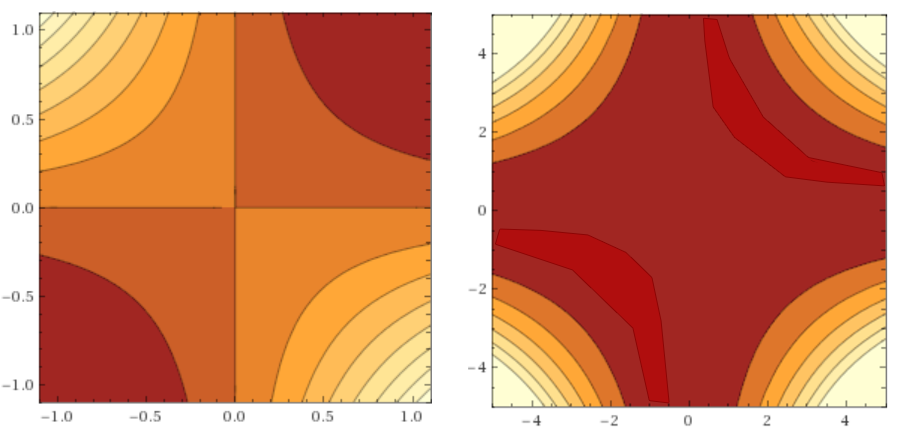
Where on the abscissa is delayed
It's obvious that
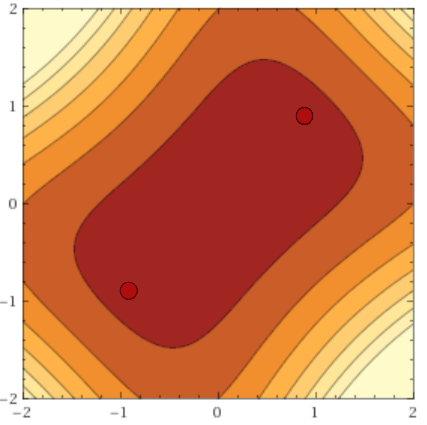
In the future, by “global minimum” I will mean “any of the identical global minimums”, and by “clot of minimums” - “any of the symmetric clusters of local minimums”.
Review of theoretical works
As you know, neural network training is the search for the minimum of the objective loss function
Until recently, there were few people wishing to tackle such a titanic task, but in early 2014 an article was published by Andrew Saxe and others [2], which discusses the nonlinear dynamics of linear learningneural networks (a formula is given for the optimal learning speed) and the best way to initialize them (orthogonal matrices). The authors get interesting calculations based on the decomposition of the product of the network weights in SVD and theorize how the results can be transferred to nonlinear networks. Although Saxe's work is not directly related to the topic of this article, it encouraged other researchers to take a deeper look at the dynamics of learning neural networks. In particular, a little later in 2014, Yann Dauphin and the team [3] review the existing literature on the dynamics of learning and pay attention not only to the Saxe article, but also to the work of Bray and Dean [4] from 2007 about statistics of critical points in random Gaussian fields. They offer a modification of the Saddle Free Newton (SFN) method, which not only escapes saddle points better, but they also do not require the calculation of the full Gaussian (minimization follows the vectors of the so-called Krylov subspace). The article demonstrates very nice graphs of improving network accuracy, which means SFN is doing something right. The Dauphin article, in turn, gives impetus to new research on the distribution of critical points in the space of weights.
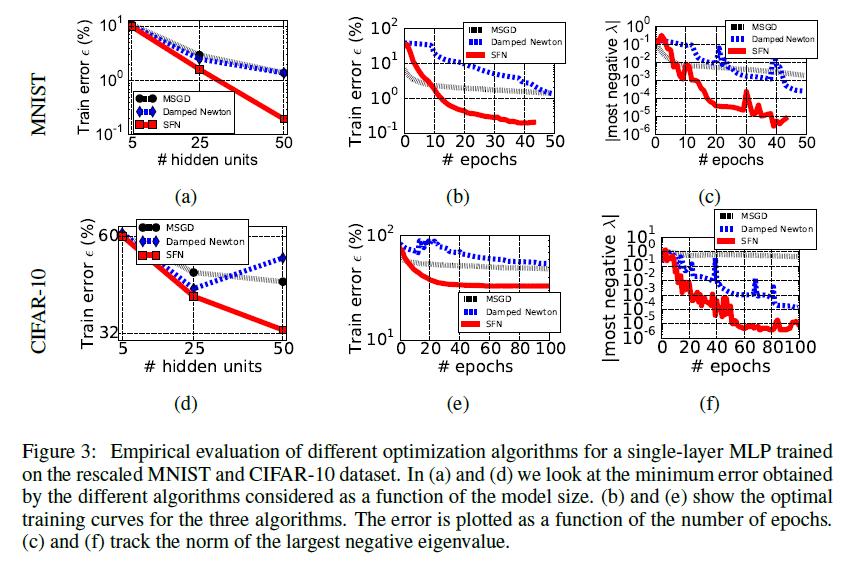
So, there are several areas of analysis of the stated problem.
The first is to steal from someone a little run-up math and apply it to your own model. This approach was incredibly successful by Anna Chromanska and the team [5] [6], using the equations of the theory of spin glasses. They limited themselves to the consideration of neural networks with the following characteristics:
- Direct distribution networks.
- Deep networks. The more weights, the better the asymptotic approximations work.
- ReLU activation features.
- L2 or Hinge loss function.
Then they imposed several more or less realistic restrictions on the model:
- The probability of a neuron being active is described by the Bernoulli distribution.
- The activation paths (which neuron activates which) are evenly distributed.
- The number of weights is excessive to form the distribution function
. There are no scales whose removal blocks learning or prediction.
- Spherical weight limit:
(Where
- the number of weights in the network)
- All input variables have a normal distribution with the same variance.
And a few unrealistic ones:
- The activation paths in the neural network are not specific
.
- Input variables are independent of each other.
On the basis of which the following statements were received:
- The minima of the loss function in the neural network form a cluster in a relatively small subspace of weights. Beyond a certain boundary, the values of the loss function their number begins to exponentially decrease.
- For properly trained deep neural networks, the majority of local minima are approximately the same in terms of performance on the test sample.
- The probability of being in a “bad” local minimum is noticeable when working with small networks and decreases exponentially with an increase in the number of parameters in the network.
- Let be
- the number of negative eigenvalues of the Hessian at the saddle point. The larger it is, the more are the ways in which gradient descent can escape from a critical point. For everybody
there is some measure of the value of the objective function
starting from which the density of saddle points with such
begins to decrease exponentially. These numbers are strictly increasing. In Russian, this means that the loss function has a layered structure, and the closer we are to the global minimum, the more there will be nasty saddle points from which it is difficult to get out.
On the one hand, we almost "free" got a lot of proven theorems, showing that under certain conditions neural networks behave in a manner consistent with spin glasses. If anything is able to open the infamous “black box” of neural networks, it’s a matan from quantum physics. But there is an obvious drawback: very strong source premises. Even 1 and 2 of the realistic group seem dubious to me, what can I say about the unrealistic group. The most serious limitation in the model seems to me a uniform distribution of activation paths. What if some small group of activation pathways is responsible for classifying 95% of the elements of the dataset? It turns out that it forms a network in the network, which at times reduces the effective
There’s an additional catch: Chromanska’s statements are hard to falsify. It is not so difficult to construct an example of weights representing a “bad” local minimum [7], but this does not seem to contradict the message of the article: their statements must be satisfied for large networks. However, even the provided set of weights for a moderately deep feed-forward network, which poorly classifies, say, MNIST is unlikely to be strong evidence, because the authors argue that the probability of encountering a “bad” local minimum tends to zero, and not that they are completely absent. Plus, “for properly trained deep neural networks” is a pretty loose concept ...

The second approach involves building a model of the simplest possible neural network and iteratively bringing it to a state where it can describe modern machine learning monsters. We have long had a basic model - these are linear neural networks (i.e. networks with activation function
At least, few people were interested until recently. Using rather weak restrictions on layer sizes and data properties, Kenji Kawaguchi [8] develops the results of [9] from 1989 and shows that in certain linear neural networks with L2-loss
- Though
non-convex and non-concave
- All local minima are global (there can be more than one)
- And all other critical points are saddle
- If
- the saddle point of the loss function and the rank of the matrix product of the network weights is equal to the rank of the narrowest layer in the neural network, then the Hessian in
has at least one strictly negative eigenvalue.
If the rank of the product is less, then the Hessian matrix can have zero eigenvalues, which means that we cannot so easily understand whether we hit a non-strict local minimum or a saddle point. Compare with features
After that, Kawaguchi takes into account networks with ReLu activation, slightly relaxes the limitations of Choromanska [6], and proves the same statements for neural networks with ReLu nonlinearities and L2-loss. (In the next paper [10], the same author gives a simpler proof). Hardt & Ma [11], inspired by calculations [8] and the success of residual learning, prove even stronger statements for linear networks with skip connections: under certain conditions, they do not even have “bad” critical points without negative eigenvalues of the Hessian (see [ 12] for theoretical justification of why “short circuits” in the network improve the landscape, and [13] for graph examples
The accumulated knowledge base is summarized by the recently appeared work of Yun, Sra & Jadbabaie [14]. The authors strengthen Kawaguchi's theorems and, like Chromanska, divide the weight space of a linear neural network into a subspace that contains only saddle points, and a subspace that contains only global minima (necessary and sufficient conditions are given). Moreover, scientists finally take a step in the direction we are interested in and prove similar statements for nonlinear neural networks. Let the latter be done with very strong prerequisites, but these are prerequisites different from the conditions of Chromanska.
Visualization Overview
The third approach is the analysis of the values of the Hessian in the learning process. Mathematicians have long been aware of second-order optimization methods. Machine learning specialists occasionally flirt with them (with methods, not with mathematicians ... albeit with mathematicians too), but even truncated second-order descent algorithms have never been particularly popular. The main reason for this lies in the cost of calculating the data necessary for descent, taking into account the second derivative. An honestly calculated Hessian takes a square of the number of memory weights: if there are a million parameters in the network, then in the matrix of the second derivatives there will be
For the same reason, there are few works allowing you to look at the dynamics of the Hessian in the learning process. More precisely, I found exactly one work by Yann LeCun and the company [34] dedicated to this, and even then they work with a relatively primitive network. Plus, in [3] and [12] there are a couple of relevant comments and graphs.
LeCun [34]: Hessian almost entirely consists of zero values throughout the training. During optimization, the Hessian histogram further compresses to zero. Nonzero values are distributed unevenly: a long tail is thrown to the positive side, while negative values are concentrated near zero. Often it only seems to us that the training stopped, while we just ended up in a pool with small gradients. At the breakpoint there are negative eigenvalues of the Hessian.
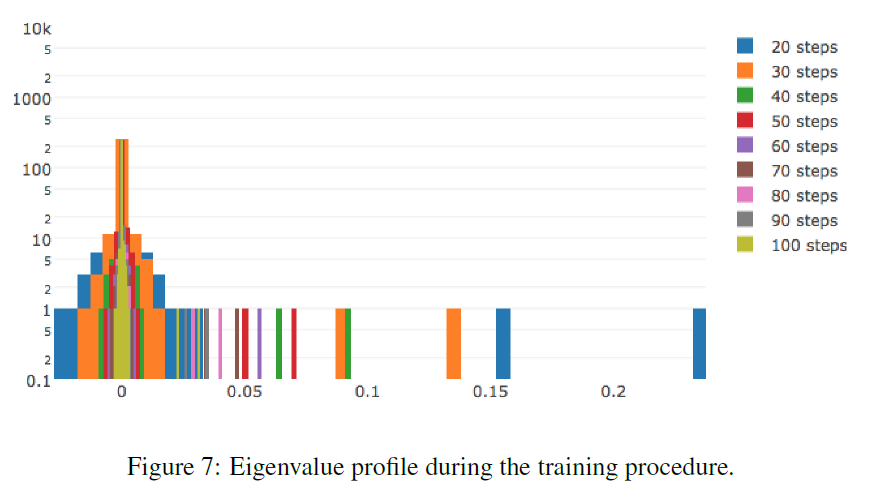
The more complex the data, the more elongated the positive tail of the distribution of eigenvalues.
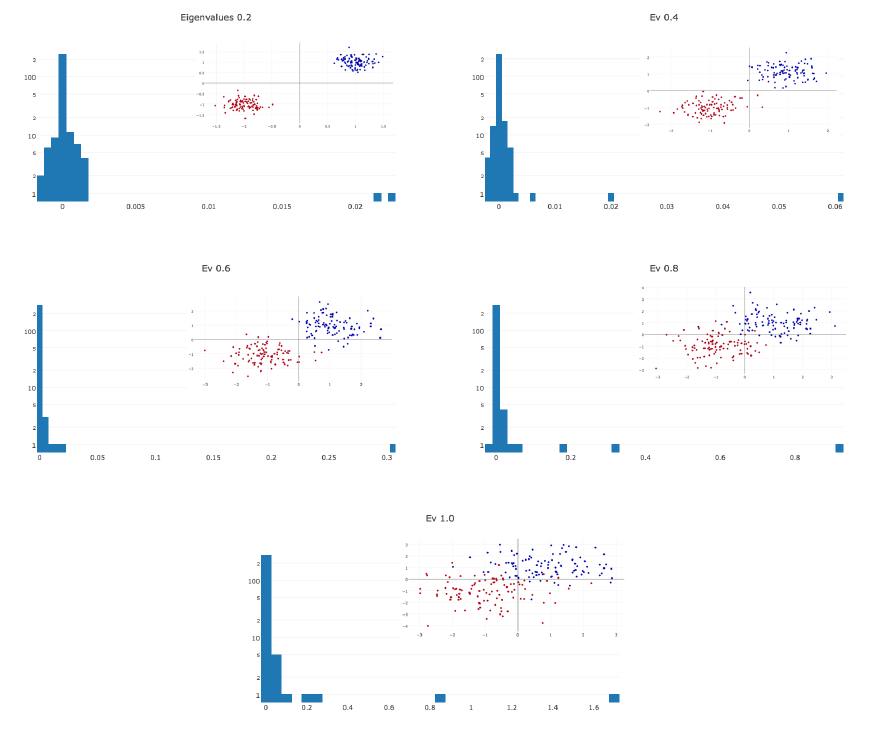
The more parameters in the network, the more stretched the histogram of eigenvalues in both directions.
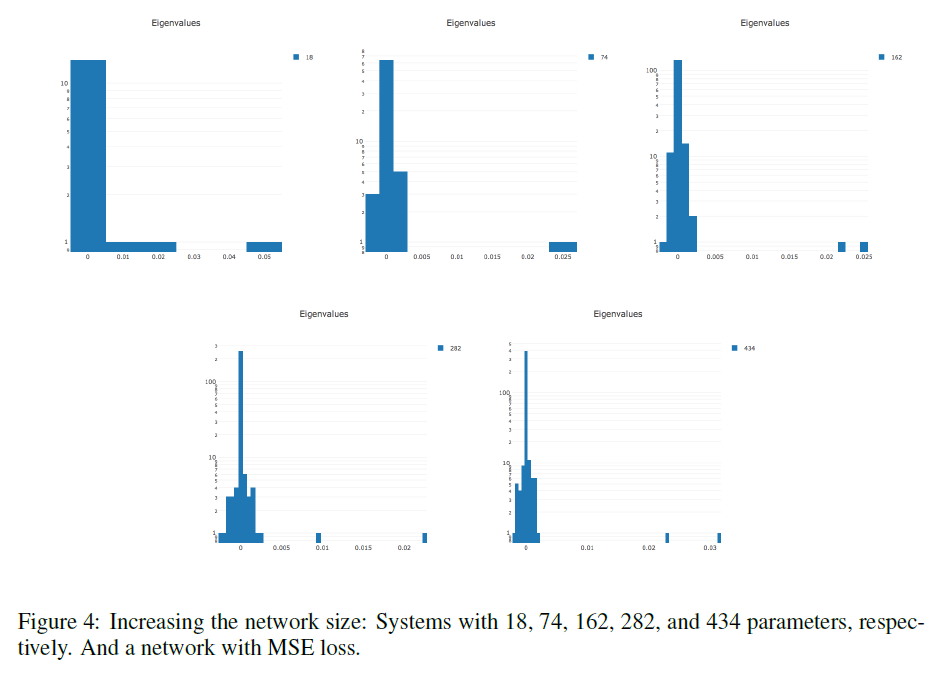
Dauphin et al. [3]: On graphs A and C along the axis
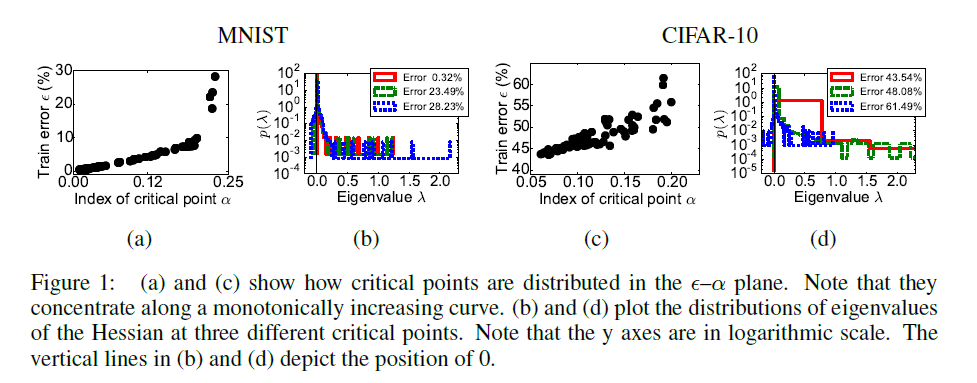
The correlation between the number of escape directions from the saddle point and the quality of the network in it is clearly visible.
Orhan & Pitkow [12]: Relative numbers of degenerate and negative eigenvalues of the Hessian are shown. The article says not quite about the same thing as in [3] and [34], but in general the graphs indirectly confirm the results of two previous works.

Fourth Way - Direct Landscape Analysis
One of these works is [16]. In it, researchers look at the gap between the launch endpoints with SGD, Adam, Adadelta, and RMSProp. As in many other works, it is found that various algorithms find characteristically different minima. Also, the authors of the article show that if during the training to change the type of algorithm, then
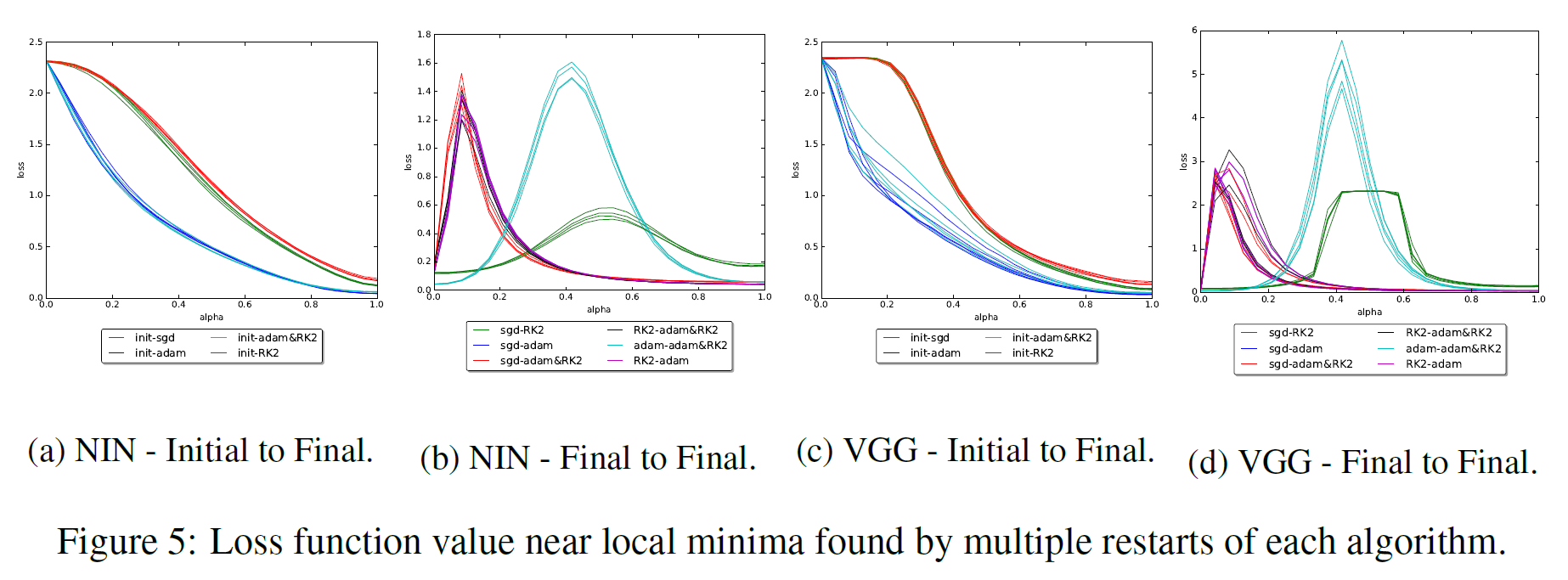
Now we are more interested in a group of studies in which it is proved that between two minima in the space of weights
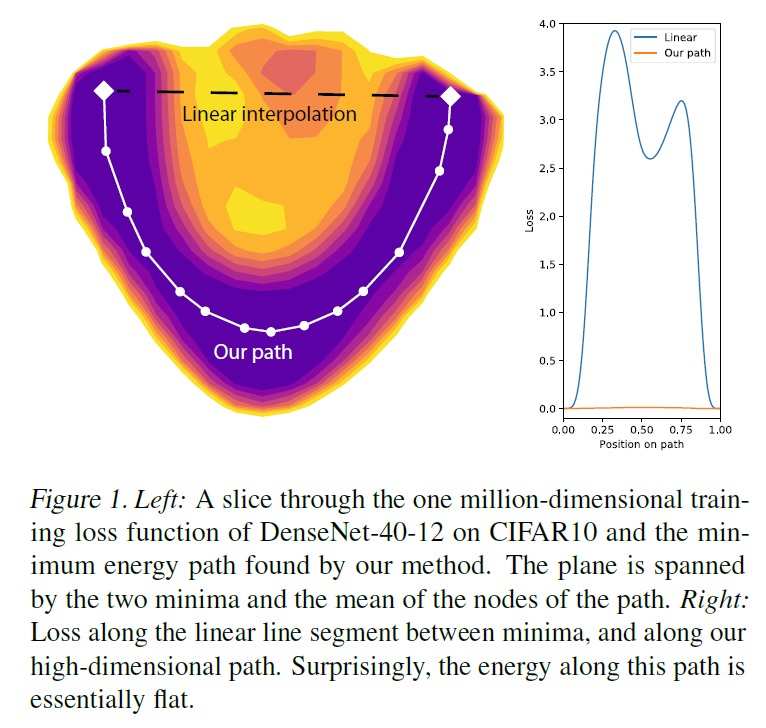
The very recent article from an international team of scientists [23], in which they build loss'a graphs between
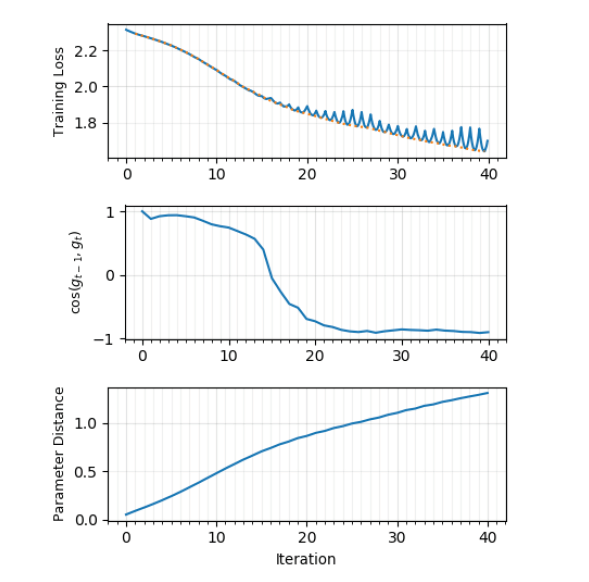
Until now, we believed that the quality of the minimum found depends only on its depth. However, many researchers note that the width of the minimum also matters. Formally, it can be defined in different ways; I will not give various formulations (see [20], if you still want to see them), it suffices to understand the main idea here. Here is an illustration: The
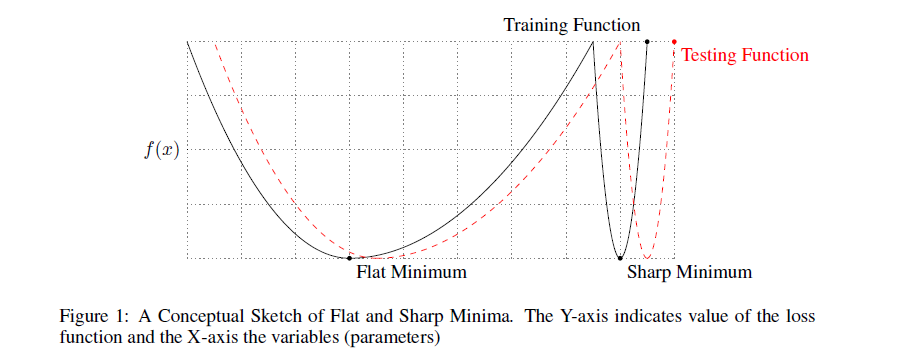
minimum of the black graph on the left is wide, on the right is narrow. Why does it matter? The distribution of training data does not exactly match the distribution of test data. It can be assumed that the minima
It has been observed in practice that gradient descent with large batch systematically achieves slightly better results in the training set, but loses in the test set. This is often due to the fact that small batch'i make noise in the estimation of the target distribution and do not allow to settle
Alas, not so simple. We are faced with the problem mentioned above: the width of the minimum depends on the parameterization [20]. In networks with ReLu activations, it’s simple enough to build an example when two sets of weights
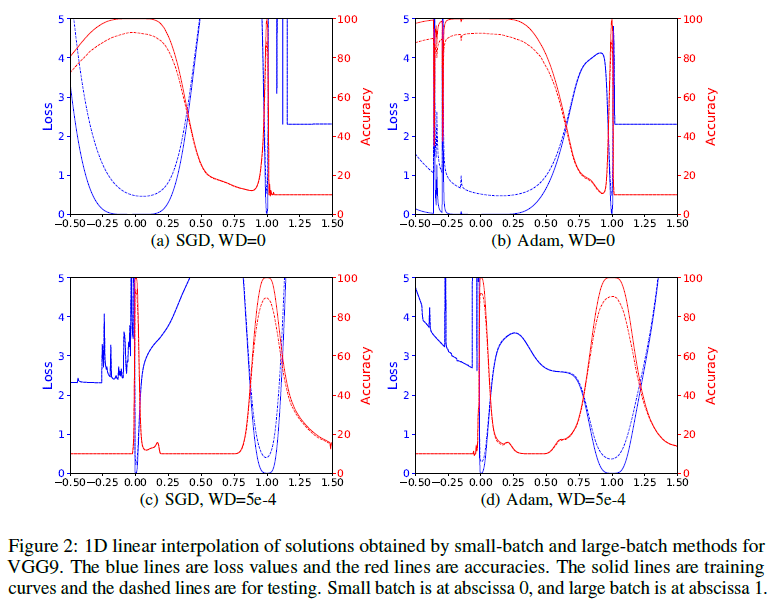
Perhaps this is due to the very modest success of the SGD modification, aimed at directing optimization to wide troughs [ 22]. Very eminent scientists demonstrate plausible histograms of the Hessians, but the increase in quality remains almost invisible.
Cross comparison
So what do we have?
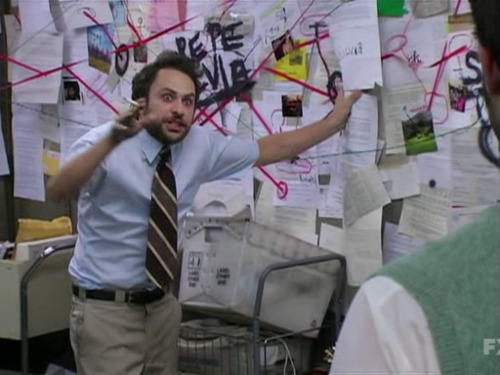
The theoretical works of Chromanska [5], Kawaguchi [8] and Yun [14] are consistent with each other. Linear neural networks are a simple special case, and it is logical that instead of the inner zone of a complex landscape we get one pure global minimum (despite the fact that there is a “saddle zone” both here and there). In [14], much stronger conditions are set for the input function.
The connection between theory and practice:
- Chromanska's claims about the complex landscape in the subspace of minima are consistent with the work on building low-energy curves between minima
[17] [18] [19], which, in turn, are consistent with the empirical success of snapshot ensembles [24]. In [19] it was theorized that the abundance of “holes” between the minima is a consequence of excessive network parameterization, and a large number of weights is the main premise in [5].
- Утверждение Chromanska о «слоях» в пространстве весов напрямую подтверждаются гистограммами собственных значений гессианов, в особенности, графиками из [3]: почти прямые линии демонстрируют сильную связь между количеством направлений побега и loss'ом.
- Из теоретических работ напрямую следует поведение полученное в [23], а именно характерное «отскакивание» от стенок ложбины.
- Утверждения о примерной равноценности минимумов согласуются с практическими результатами (сильно ли разнятся loss'ы среди первых десяти мест в типичном каггельном соревновании?), но косвенно антикоррелируют с анализом, какие фичи выучиваются в разные прогоны обучения[25]. Пока неясно, как всё это соотносится с проблемой узких/широких минимумов.
- [12] и [11], которые согласуются с [8] и [14], сами по себе хорошо соотносятся с опытом применения residual learning на практике, а также подтверждаются визуализациями в [13].
- Все вышеперечисленные утверждения совпадают с общими наблюдениями, что даже обычный SGD без накопления импульса стабильно даёт результат не сильно хуже, чем Adam и другие адаптивные алгоритмы градиентного спуска[26][27]. Если бы на пути у SGD встречалось много ловушек, мы бы наблюдали совсем другую картину. Также, если вы запустите обучение сети 100 раз, то скорее всего получите 100 сетей которые выдают примерно одинаковые показатели на валидационной выборке. У вас почти наверняка не будет резких скачков вниз или вверх, что соответствовало бы найденному плохому или, наоборот, слишком хорошему минимуму.
- Во многих работах уточняется, что хоть теоретический анализ полагается на избыточное количество весов, для работы нейросети большая их часть не нужна. «Лишние» веса выполняют другие функции: во-первых, они «берут на себя» полезные сигналы, позволяя перестраиваться нейронам, которые уже несут положительную нагрузку[19], во-вторых, благодаря им в ландшафте целевой функции образуются хорошие пути спуска[32] (сравните с графиками для вариационной оптимизации в [31]), а в-третьих, благодаря им при инициализации сеть с большей вероятностью окажется в области весов, откуда оптимизация вообще начнётся[33]. Утверждение об избыточности параметризации хорошо коррелирует с успехом работ по сжатию сетей (optimal brain damage, и прочее).
In my opinion, the statement remains unproven that you should not look for a global minimum, because it will have the same generalizing ability as the local minima scattered around it. Empirical experience suggests that networks obtained by different starts of the same minimizer make mistakes on different elements (see dissonance graphs, for example, in [16] or in any work devoted to network ensemble). The analysis of learned features says the same thing. In [25], the point is advocated that most of the most useful features are stably learned, but some of the auxiliary ones are not. Should all rare filters be combined, should it be better? Again, recall the ensembles consisting of different versions of the same model [24] and the redundancy of weights in the neural network [28]. It inspires confidence that somehow it’s possible to take the best from every launch of the model and to greatly improve the predictions without changing the model itself. If the terrain in a bunch of minima is really impenetrably impassable for gradient descent, it seems to me that upon reaching it you can try switching from SGD to evolutionary strategies [31] or something similar.
However, these are also just unproven thoughts. Perhaps, indeed, you should not look for a black cat in a black million-dimensional hyperspace if it is not there; it's stupid to fight for the fifth decimal places in the loss. A clear understanding of this would give the scientific community an impetus to concentrate on new network architectures. ResNet is good, why can't you come up with something else? Also, do not forget about the pre- and post-processing of data. If possible, convert
In general, it is worth recalling once again that “find the global minimum of the loss function”
Where, in my opinion, should the scientific community move on?
- We need to try new modified methods of gradient descent, which are well able to cross the terrain with saddle points. Preferably, first-order methods, with a Hessian, any fool can. There are already works on this subject with pretty looking grafts [29] [30], but there are still many low-hanging fruits in this area of research.
- I would like to know more about the subspace of lows. What are its properties? Is it possible, having received a sufficient number of local minima, to estimate where the global, or at least better local, will be located?
- Theoretical studies are concentrated mainly on L2-loss'e. It would be interesting to see how cross-entropy affects the landscape.
- The situation with wide / narrow lows is unclear.
- The question remains about the quality of the global minimum.
If there are students among readers who will soon defend a diploma in machine learning, I would advise them to try the first task. If you know which way to look, it’s much easier to come up with something healthy. It is also interesting to try to replicate the work of LeCun [34], varying the input data.
That's all for now. Follow the events in the scientific world.
Thanks to asobolev from the Open Data Science community for the productive discussion.
List of references
[1] Blum, A. L. and Rivest, R. L.; Training a 3-node neural network is np-complete; 1992.
[2] Saxe, McClelland & Ganguli; Exact solutions to the nonlinear dynamics of learning in deep linear neural networks; 19 Feb 2014. (305 цитат на Google Scholar)
[3] Yann N. Dauphin et al; Identifying and attacking the saddle point problem in high-dimensional non-convex optimization; 10 Jun 2014 (372 циатат на Google Scholar, обратите внимание на эту статью)
[4] Alan J. Bray and David S. Dean; The statistics of critical points of Gaussian fields on large-dimensional spaces; 2007
[5] Anna Choromanska et al; The Loss Surfaces of Multilayer Networks; 21 Jan 2015 (317 цитат на Google Scholar, обратите внимание на эту статью)
[6] Anna Choromanska et al; Open Problem: The landscape of the loss surfaces of multilayer networks; 2015
[7] Grzegorz Swirszcz, Wojciech Marian Czarnecki & Razvan Pascanu; Local Minima in Training of Neural Networks; 17 Feb 2017
[8] Kenji Kawaguchi; Deep Learning without Poor Local Minima; 27 Dec 2016. (70 цитат на Research Gate, обратите внимание на эту статью)
[9] Baldi, Pierre, & Hornik, Kurt; Neural networks and principal component analysis: Learning from examples without local minima; 1989.
[9] Haihao Lu & Kenji Kawaguchi; Depth Creates No Bad Local Minima; 24 May 2017.
[11] Moritz Hardt and Tengyu Ma; Identity matters in deep learning; 11 Dec 2016.
[12] A. Emin Orhan, Xaq Pitkow; Skip Connections Eliminate Singularities; 4 Mar 2018
[13] Hao Li, Zheng Xu, Gavin Taylor, Christoph Studer, Tom Goldstein; Visualizing the Loss Landscape of Neural Nets; 5 Mar 2018 (обратите внимание на эту статью)
[14] Chulhee Yun, Suvrit Sra & Ali Jadbabaie; Global Optimality Conditions for Deep Neural Networks; 1 Feb 2018 (обратите внимание на эту статью)
[15] Kkat; Fallout: Equestria; 25 Jan, 2012
[16] Daniel Jiwoong Im, Michael Tao and Kristin Branson; An Empirical Analysis of Deep Network Loss Surhaces.
[17] C. Daniel Freeman; Topology and Geometry of Half-Rectified Network Optimization; 1 Jun 2017.
[18] Timur Garipov, Pavel Izmailov, Dmitrii Podoprikhin, Dmitry Vetrov, Andrew Gordon Wilson; Loss Surfaces, Mode Connectivity, and Fast Ensembling of DNNs; 1 Mar 2018
[19] Felix Draxler, Kambis Veschgini, Manfred Salmhofer, Fred A. Hamprecht; Essentially No Barriers in Neural Network Energy Landscape; 2 Mar 2018 (обратите внимание на эту статью)
[20] Laurent Dinh, Razvan Pascanu, Samy Bengio, Yoshua Bengio; Sharp Minima Can Generalize For Deep Nets; 15 May 2017
[21] Nitish Shirish Keskar, Dheevatsa Mudigere, Jorge Nocedal, Mikhail Smelyanskiy and Ping Tak Peter Tang; On Large-batch Training for Deep Learning: Generalization Gap and Sharp Minima; 9 Feb 2017
[22] Pratik Chaudhari, Anna Choromanska, Stefano Soatto, Yann LeCun, Carlo Baldassi, Christian Borgs, Jennifer Chayes, Levent Sagun, Riccardo Zecchina; Entropy-SGD: Biasing Gradient Descent into Wide Valleys; 21 Apr 2017
[23] Chen Xing, Devansh Arpit, Christos Tsirigotis, Yoshua Bengio; A Walk with SGD; 7 Mar 2018
[24] habrahabr.ru/post/332534
[25] Yixuan Li, Jason Yosinski, Jeff Clune, Hod Lipson, & John Hopcroft; Convergent Learning: Do Different Neural Networks Learn the Same Representations? 28 Feb 2016 (обратите внимание на эту статью)
[26] Ashia C. Wilson, Rebecca Roelofs, Mitchell Stern, Nathan Srebro and Benjamin Recht; The Marginal Value of Adaptive Gradient Methods in Machine Learning
[27] shaoanlu.wordpress.com/2017/05/29/sgd-all-which-one-is-the-best-optimizer-dogs-vs-cats-toy-experiment
[28] Misha Denil, Babak Shakibi, Laurent Dinh, Marc'Aurelio Ranzato, Nando de Freitas; Predicting Parameters in Deep Learning; 27 Oct 2014
[29] Armen Aghajanyan; Charged Point Normalization: An Efficient Solution to the Saddle Point Problem; 29 Sep 2016.
[30] Haiping Huang, Taro Toyoizumi; Reinforced stochastic gradient descent for deep neural network learning; 22 Nov 2017.
[31] habrahabr.ru/post/350136
[32] Quynh Nguyen, Matthias Hein; The Loss Surface of Deep and Wide Neural Networks; 12 Jun 2017
[33] Itay Safran, Ohad Shamir; On the Quality of the Initial Basin in Overspecified Neural Networks; 14 Jun 2016
[34] Levent Sagun, Leon Bottou, Yann LeCun; Eigenvalues of the Hessian in Deep Learning: Singularity and Beyond; 5 Oct 2017
[35] www.argmin.net/2016/04/18/bottoming-out
[2] Saxe, McClelland & Ganguli; Exact solutions to the nonlinear dynamics of learning in deep linear neural networks; 19 Feb 2014. (305 цитат на Google Scholar)
[3] Yann N. Dauphin et al; Identifying and attacking the saddle point problem in high-dimensional non-convex optimization; 10 Jun 2014 (372 циатат на Google Scholar, обратите внимание на эту статью)
[4] Alan J. Bray and David S. Dean; The statistics of critical points of Gaussian fields on large-dimensional spaces; 2007
[5] Anna Choromanska et al; The Loss Surfaces of Multilayer Networks; 21 Jan 2015 (317 цитат на Google Scholar, обратите внимание на эту статью)
[6] Anna Choromanska et al; Open Problem: The landscape of the loss surfaces of multilayer networks; 2015
[7] Grzegorz Swirszcz, Wojciech Marian Czarnecki & Razvan Pascanu; Local Minima in Training of Neural Networks; 17 Feb 2017
[8] Kenji Kawaguchi; Deep Learning without Poor Local Minima; 27 Dec 2016. (70 цитат на Research Gate, обратите внимание на эту статью)
[9] Baldi, Pierre, & Hornik, Kurt; Neural networks and principal component analysis: Learning from examples without local minima; 1989.
[9] Haihao Lu & Kenji Kawaguchi; Depth Creates No Bad Local Minima; 24 May 2017.
[11] Moritz Hardt and Tengyu Ma; Identity matters in deep learning; 11 Dec 2016.
[12] A. Emin Orhan, Xaq Pitkow; Skip Connections Eliminate Singularities; 4 Mar 2018
[13] Hao Li, Zheng Xu, Gavin Taylor, Christoph Studer, Tom Goldstein; Visualizing the Loss Landscape of Neural Nets; 5 Mar 2018 (обратите внимание на эту статью)
[14] Chulhee Yun, Suvrit Sra & Ali Jadbabaie; Global Optimality Conditions for Deep Neural Networks; 1 Feb 2018 (обратите внимание на эту статью)
[15] Kkat; Fallout: Equestria; 25 Jan, 2012
[16] Daniel Jiwoong Im, Michael Tao and Kristin Branson; An Empirical Analysis of Deep Network Loss Surhaces.
[17] C. Daniel Freeman; Topology and Geometry of Half-Rectified Network Optimization; 1 Jun 2017.
[18] Timur Garipov, Pavel Izmailov, Dmitrii Podoprikhin, Dmitry Vetrov, Andrew Gordon Wilson; Loss Surfaces, Mode Connectivity, and Fast Ensembling of DNNs; 1 Mar 2018
[19] Felix Draxler, Kambis Veschgini, Manfred Salmhofer, Fred A. Hamprecht; Essentially No Barriers in Neural Network Energy Landscape; 2 Mar 2018 (обратите внимание на эту статью)
[20] Laurent Dinh, Razvan Pascanu, Samy Bengio, Yoshua Bengio; Sharp Minima Can Generalize For Deep Nets; 15 May 2017
[21] Nitish Shirish Keskar, Dheevatsa Mudigere, Jorge Nocedal, Mikhail Smelyanskiy and Ping Tak Peter Tang; On Large-batch Training for Deep Learning: Generalization Gap and Sharp Minima; 9 Feb 2017
[22] Pratik Chaudhari, Anna Choromanska, Stefano Soatto, Yann LeCun, Carlo Baldassi, Christian Borgs, Jennifer Chayes, Levent Sagun, Riccardo Zecchina; Entropy-SGD: Biasing Gradient Descent into Wide Valleys; 21 Apr 2017
[23] Chen Xing, Devansh Arpit, Christos Tsirigotis, Yoshua Bengio; A Walk with SGD; 7 Mar 2018
[24] habrahabr.ru/post/332534
[25] Yixuan Li, Jason Yosinski, Jeff Clune, Hod Lipson, & John Hopcroft; Convergent Learning: Do Different Neural Networks Learn the Same Representations? 28 Feb 2016 (обратите внимание на эту статью)
[26] Ashia C. Wilson, Rebecca Roelofs, Mitchell Stern, Nathan Srebro and Benjamin Recht; The Marginal Value of Adaptive Gradient Methods in Machine Learning
[27] shaoanlu.wordpress.com/2017/05/29/sgd-all-which-one-is-the-best-optimizer-dogs-vs-cats-toy-experiment
[28] Misha Denil, Babak Shakibi, Laurent Dinh, Marc'Aurelio Ranzato, Nando de Freitas; Predicting Parameters in Deep Learning; 27 Oct 2014
[29] Armen Aghajanyan; Charged Point Normalization: An Efficient Solution to the Saddle Point Problem; 29 Sep 2016.
[30] Haiping Huang, Taro Toyoizumi; Reinforced stochastic gradient descent for deep neural network learning; 22 Nov 2017.
[31] habrahabr.ru/post/350136
[32] Quynh Nguyen, Matthias Hein; The Loss Surface of Deep and Wide Neural Networks; 12 Jun 2017
[33] Itay Safran, Ohad Shamir; On the Quality of the Initial Basin in Overspecified Neural Networks; 14 Jun 2016
[34] Levent Sagun, Leon Bottou, Yann LeCun; Eigenvalues of the Hessian in Deep Learning: Singularity and Beyond; 5 Oct 2017
[35] www.argmin.net/2016/04/18/bottoming-out
